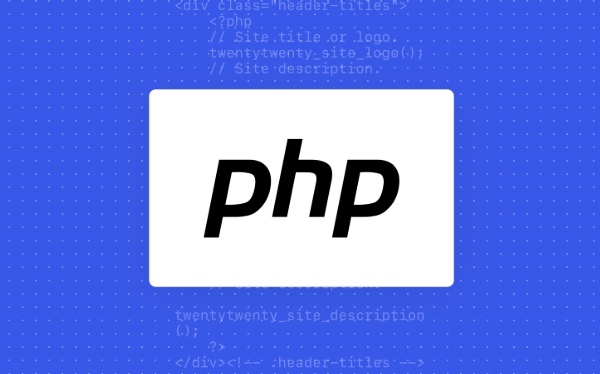php function to validate an email address
Verifying email addresses is a common task in PHP, mainly by using the filter_var() function with the FILTER_VALIDATE_EMAIL filter. This is the easiest and reliable method. It can check the correctness of the email format, including the correct location of the @ symbol and domain name part, the valid characters of the local part, and the validity of the domain name format, but does not verify whether the mailbox is real; secondly, although it can be used for verification, due to the email grid The formula is complex, and custom regularity is prone to errors. It is not recommended unless there are special needs. In addition, you can optionally check whether the domain name has MX records in combination with the checkdnsrr() function to confirm that the domain name can theoretically receive emails, but this step may slow or fail due to DNS problems. Finally, the input should be cleaned before verification, such as using the FILTER_SANITIZE_EMAIL filter to remove excess characters to avoid verification errors; in summary, the recommended practices are: 1. Use filter_var for format verification; 2. Optionally add DNS checks; 3. Avoid custom rules; 4. Clean input before verification.

Validating an email address in PHP is a common task, especially when handling user registration, contact forms, or any kind of input where email format matters. While there's no one-size-fits-all solution due to the complexity of email standards, there are solid methods you can use to make sure an email is at least in a valid format.

Use filter_var with FILTER_VALIDATE_EMAIL
The simplest and most reliable built-in method in PHP is using filter_var() with the FILTER_VALIDATE_EMAIL filter. It's designed specifically for this purpose and handles most standard email formats correctly.
$email = "test@example.com";
if (filter_var($email, FILTER_VALIDATE_EMAIL)) {
echo "Email is valid.";
} else {
echo "Email is not valid.";
}This approach checks for:

- Proper placement of @ and domain part
- Valid characters in the local part (before the @)
- A valid domain name format
It won't check if the email actually exists—that requires additional steps like SMTP checks or sending a confirmation link.
Don't try to write your own regex unless you have to
Some developers try to write their own regular expressions to validate emails. While it's possible, it's also error-prone because the official email format is extremely complex.

A commonly used regex like this one:
$email = "user.name@domain.co.uk";
if (preg_match("/^[a-zA-Z0-9._% -] @[a-zA-Z0-9.-] \.[a-zA-Z]{2,}$/", $email)) {
echo "Valid format.";
} ...might work for most common cases, but still might miss some edge cases or block valid addresses. So unless you have a specific reason to use regex (like enforcing stricter rules for your app), stick with filter_var() .
Combine with DNS checks (optional but stronger validation)
If you want to go a step beyond format validation and check if the domain could receive emails, you can use checkdnsrr() to verify that the domain has valid MX records.
$domain = substr(strrchr($email, "@"), 1);
if (checkdnsrr($domain, "MX")) {
echo "Domain can receive email.";
}Keep in mind:
- This doesn't confirm the email exists
- It only checks if the domain is configured to receive emails
- It can be slow or fail due to DNS issues
So it's a nice optional step but shouldn't be required unless you have a specific need.
Sanitize before validating
Before validating, it's a good idea to clean the email string a bit to avoid false negatives:
$email = trim(filter_input(INPUT_POST, 'email', FILTER_SANITIZE_EMAIL));
Sanitizing removes unwanted characters like extra spaces or special symbols that might break the validation even if the user intended a valid email.
So to put it all together:
- Use
filter_var($email, FILTER_VALIDATE_EMAIL)for most cases - Optionally add DNS checks if you want stronger domain validation
- Avoid writing your own regex unless you have a clear reason
- Always sanitize the input before validating
Basically that's it.
The above is the detailed content of php function to validate an email address. For more information, please follow other related articles on the PHP Chinese website!

Hot AI Tools

Undress AI Tool
Undress images for free

Undresser.AI Undress
AI-powered app for creating realistic nude photos

AI Clothes Remover
Online AI tool for removing clothes from photos.

Clothoff.io
AI clothes remover

Video Face Swap
Swap faces in any video effortlessly with our completely free AI face swap tool!

Hot Article

Hot Tools

Notepad++7.3.1
Easy-to-use and free code editor

SublimeText3 Chinese version
Chinese version, very easy to use

Zend Studio 13.0.1
Powerful PHP integrated development environment

Dreamweaver CS6
Visual web development tools

SublimeText3 Mac version
God-level code editing software (SublimeText3)
 PHP Variable Scope Explained
Jul 17, 2025 am 04:16 AM
PHP Variable Scope Explained
Jul 17, 2025 am 04:16 AM
Common problems and solutions for PHP variable scope include: 1. The global variable cannot be accessed within the function, and it needs to be passed in using the global keyword or parameter; 2. The static variable is declared with static, and it is only initialized once and the value is maintained between multiple calls; 3. Hyperglobal variables such as $_GET and $_POST can be used directly in any scope, but you need to pay attention to safe filtering; 4. Anonymous functions need to introduce parent scope variables through the use keyword, and when modifying external variables, you need to pass a reference. Mastering these rules can help avoid errors and improve code stability.
 How to handle File Uploads securely in PHP?
Jul 08, 2025 am 02:37 AM
How to handle File Uploads securely in PHP?
Jul 08, 2025 am 02:37 AM
To safely handle PHP file uploads, you need to verify the source and type, control the file name and path, set server restrictions, and process media files twice. 1. Verify the upload source to prevent CSRF through token and detect the real MIME type through finfo_file using whitelist control; 2. Rename the file to a random string and determine the extension to store it in a non-Web directory according to the detection type; 3. PHP configuration limits the upload size and temporary directory Nginx/Apache prohibits access to the upload directory; 4. The GD library resaves the pictures to clear potential malicious data.
 Commenting Out Code in PHP
Jul 18, 2025 am 04:57 AM
Commenting Out Code in PHP
Jul 18, 2025 am 04:57 AM
There are three common methods for PHP comment code: 1. Use // or # to block one line of code, and it is recommended to use //; 2. Use /.../ to wrap code blocks with multiple lines, which cannot be nested but can be crossed; 3. Combination skills comments such as using /if(){}/ to control logic blocks, or to improve efficiency with editor shortcut keys, you should pay attention to closing symbols and avoid nesting when using them.
 How Do Generators Work in PHP?
Jul 11, 2025 am 03:12 AM
How Do Generators Work in PHP?
Jul 11, 2025 am 03:12 AM
AgeneratorinPHPisamemory-efficientwaytoiterateoverlargedatasetsbyyieldingvaluesoneatatimeinsteadofreturningthemallatonce.1.Generatorsusetheyieldkeywordtoproducevaluesondemand,reducingmemoryusage.2.Theyareusefulforhandlingbigloops,readinglargefiles,or
 Tips for Writing PHP Comments
Jul 18, 2025 am 04:51 AM
Tips for Writing PHP Comments
Jul 18, 2025 am 04:51 AM
The key to writing PHP comments is to clarify the purpose and specifications. Comments should explain "why" rather than "what was done", avoiding redundancy or too simplicity. 1. Use a unified format, such as docblock (/*/) for class and method descriptions to improve readability and tool compatibility; 2. Emphasize the reasons behind the logic, such as why JS jumps need to be output manually; 3. Add an overview description before complex code, describe the process in steps, and help understand the overall idea; 4. Use TODO and FIXME rationally to mark to-do items and problems to facilitate subsequent tracking and collaboration. Good annotations can reduce communication costs and improve code maintenance efficiency.
 How to access a character in a string by index in PHP
Jul 12, 2025 am 03:15 AM
How to access a character in a string by index in PHP
Jul 12, 2025 am 03:15 AM
In PHP, you can use square brackets or curly braces to obtain string specific index characters, but square brackets are recommended; the index starts from 0, and the access outside the range returns a null value and cannot be assigned a value; mb_substr is required to handle multi-byte characters. For example: $str="hello";echo$str[0]; output h; and Chinese characters such as mb_substr($str,1,1) need to obtain the correct result; in actual applications, the length of the string should be checked before looping, dynamic strings need to be verified for validity, and multilingual projects recommend using multi-byte security functions uniformly.
 Quick PHP Installation Tutorial
Jul 18, 2025 am 04:52 AM
Quick PHP Installation Tutorial
Jul 18, 2025 am 04:52 AM
ToinstallPHPquickly,useXAMPPonWindowsorHomebrewonmacOS.1.OnWindows,downloadandinstallXAMPP,selectcomponents,startApache,andplacefilesinhtdocs.2.Alternatively,manuallyinstallPHPfromphp.netandsetupaserverlikeApache.3.OnmacOS,installHomebrew,thenrun'bre
 Learning PHP: A Beginner's Guide
Jul 18, 2025 am 04:54 AM
Learning PHP: A Beginner's Guide
Jul 18, 2025 am 04:54 AM
TolearnPHPeffectively,startbysettingupalocalserverenvironmentusingtoolslikeXAMPPandacodeeditorlikeVSCode.1)InstallXAMPPforApache,MySQL,andPHP.2)Useacodeeditorforsyntaxsupport.3)TestyoursetupwithasimplePHPfile.Next,learnPHPbasicsincludingvariables,ech







